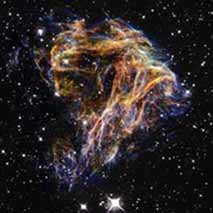Supernova Explosions
Back to main Supernova Explosions page
Type II supernova explosions provide solid proof to many of the contentions that I have raised throughout my work. Supernovas are “neutronic”/magnetic stars, which comprise the magnetic part of a wave formation. While a comprehensive explanation of supernova explosions can fill an entire library, I will limit this discussion to the facets which pertain to wave theory.
The size of a particular energetic wave formation depends on its energetic
loop. Since the supernova is actually a magnetic loop, its size before
the explosion is relatively
small. Its disintegration generates radiation that is emitted in extremely
short waves. The particles that it expels are also endowed with the properties
of neutrons and we thus refer to them as neutrinos (see adjacent picture).
Neutrinos are characterized by small energetic loops (space), narrow wave
bands, and extremely high rates of rotation (in contrast to formations
with large energetic loops that rotate at a slower pace and have broader
bands.
Most of what remains of a star that loses its energetic loop is its gravitational-magnetic
loop. Consequently, it is essentially rendered a neutron that has a substantial
gravitational impact on a limited condensed space. In fact, energy is
constantly escaping from neutrons in various ways. These formations of
energetic matter align into condensed areas of the particular star, and
ultimately precipitate an explosion that results the collapse of part
of the star. However, this explosion — similar to the startup fuel
of an atomic bomb — merely sets the stage for a second, emphatic
blast in which the entire star disintegrates into a sparkling array of
energetic matter (quarks) and other energetic formations.
Following the second, colossal explosion, the star’s scattered energy/quarks
begin to create a new formation, which constitutes the nascent stages
of a new life cycle (see pictures below). In other words, the released
energy produces a new wave formation that aligns into a classic, two-loop
formation, and the waves’ black hole potentiates the new entity’s
energetic circulation.
 |
|
Sheets of debris from the explosion of Supernova N49 |
Its energetic paths, by dint of their peculiar movement, create a swirl that induces the energetic matter to return to its source (for more information on this process, please refer to the articles on Photons and Gravitation). Type II supernova explosions are thus fabulous two-step processes.

Supernova 1987A Rings
As mentioned above, supernova explosions resemble atomic explosions. Therefore, much of our knowledge on the supernova explosion applies to atomic blasts as well. Scientists have claimed that, given earth’s considerable mass, atomic explosions do not have much of an impact on our planet. However, this is a profound mistake!!! Earth is merely an energetic-magnetic formation that is comprised of living energetic streams, and most of the planet’s energetic activity derives from the earth’s core. Excess energy that is produced by these activities is assembled into compact storage points before being released by natural channels, such as volcanoes and earthquakes. Therefore, the potentially apocalyptic possibility exists that the thrust of a subterranean nuclear explosion will collide with a condensed energetic space.
Interestingly, our solar system contains an assortment of debris (an asteroid belt) that may derive from the explosive disintegration of an entire planet that was apparently located between Mars and Jupiter. Although it is unclear what precipitated this hypothetical explosion, the extinct planet’s energetic path that was engendered by the sun has remained intact, which has enabled the residue to continue orbiting around the sun.
Due to the singular behavior and ubiquitous presence of energetic matter, wave theory asserts that many ostensibly distinct natural phenomenon are actually quite similar, if not the same. Our ability to discern these correlations may lead to significant advances in many disciplines and help mankind avert some of the disasters that we seem to be heading towards.
- end -
Dr. Chaim Tejman, Copyright© 2001. All rights reserved.